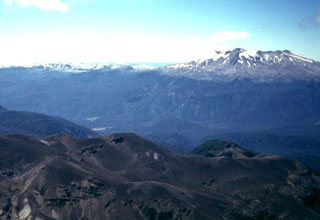Report on Puyehue-Cordon Caulle (Chile) — 22 June-28 June 2011
Smithsonian Institution / US Geological Survey
Weekly Volcanic Activity Report, 22 June-28 June 2011
Managing Editor: Sally Sennert.
Please cite this report as:
Global Volcanism Program, 2011. Report on Puyehue-Cordon Caulle (Chile) (Sennert, S, ed.). Weekly Volcanic Activity Report, 22 June-28 June 2011. Smithsonian Institution and US Geological Survey.
Puyehue-Cordon Caulle
Chile
40.59°S, 72.117°W; summit elev. 2236 m
All times are local (unless otherwise noted)
OVDAS-SERNAGEOMIN reported that the eruption continued from the Cordón Caulle rift zone, part of the Puyehue-Cordón Caulle volcanic complex. During 22 and 24-26 June cameras installed around the volcano recorded ash plumes that rose 2-4 km above the crater and drifted NW, N, and NE. Although meteorological cloud cover prevented camera observations on 23 and 28 June, the Buenos Aires VAAC reported that ash clouds detected in satellite imagery rose to altitudes of 4-4.6 km (13,000-15,000 ft) a.s.l. and drifted E and NE. On 25 June SERNAGEOMIN noted that satellite images showed that the plume drifted 200 km N then an additional 900 km NNE. The next day the plume drifted 250 km N, then turned NNW and drifted 1,450 km. According to news articles, numerous flights in and around Argentina and Chile were cancelled, as well as some flights in Uruguay.
On 27 June satellite images detected a plume that was dense for 300 m then was no longer discernable due to meteorological clouds. News outlets noted that flights in New Zealand had resumed. Ashfall was periodically reported in areas downwind, including in Riñinahue (5-10 mm of ash) Llifen, Futrono, and Curarrehue on 22 June, and Riñinahue, Pucón, and Melipeuco (in the region of Araucanía) on 25 June. Although there were no new aerial observations during 22-27 June, pulses of high-intensity tremor indicated that the lava flow remained active. The Alert Level remained at 6, Red.
Geological Summary. The Puyehue-Cordón Caulle volcanic complex (PCCVC) is a large NW-SE-trending late-Pleistocene to Holocene basaltic-to-rhyolitic transverse volcanic chain SE of Lago Ranco. The 1799-m-high Pleistocene Cordillera Nevada caldera lies at the NW end, separated from Puyehue stratovolcano at the SE end by the Cordón Caulle fissure complex. The Pleistocene Mencheca volcano with Holocene flank cones lies NE of Puyehue. The basaltic-to-rhyolitic Puyehue volcano is the most geochemically diverse of the PCCVC. The flat-topped, 2236-m-high volcano was constructed above a 5-km-wide caldera and is capped by a 2.4-km-wide Holocene summit caldera. Lava flows and domes of mostly rhyolitic composition are found on the E flank. Historical eruptions originally attributed to Puyehue, including major eruptions in 1921-22 and 1960, are now known to be from the Cordón Caulle rift zone. The Cordón Caulle geothermal area, occupying a 6 x 13 km wide volcano-tectonic depression, is the largest active geothermal area of the southern Andes volcanic zone.
Sources: Buenos Aires Volcanic Ash Advisory Center (VAAC), Servicio Nacional de Geología y Minería (SERNAGEOMIN), Associated Press, Agence France-Presse (AFP), Big Pond News

